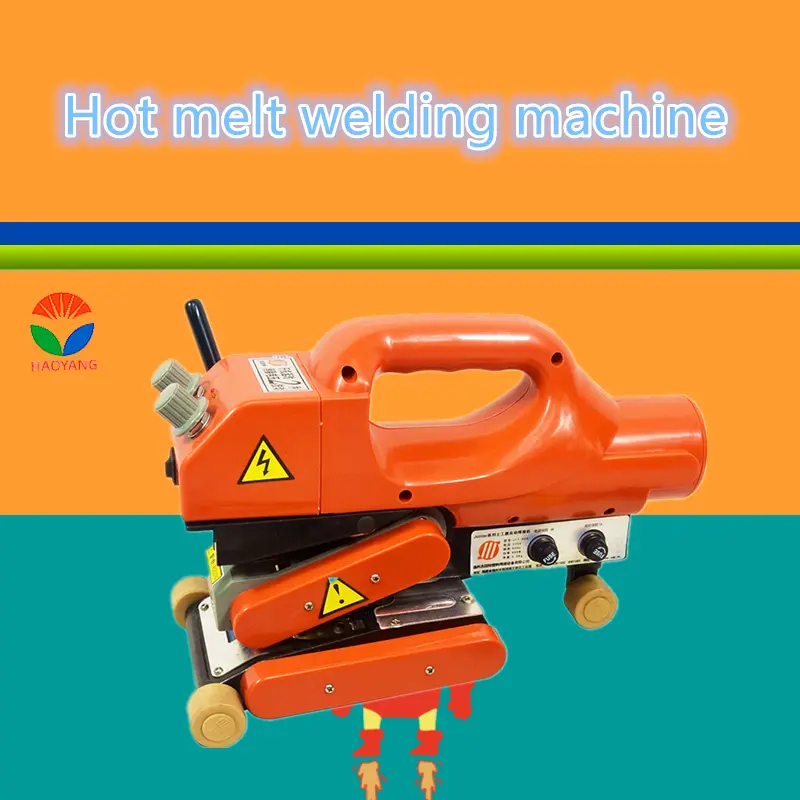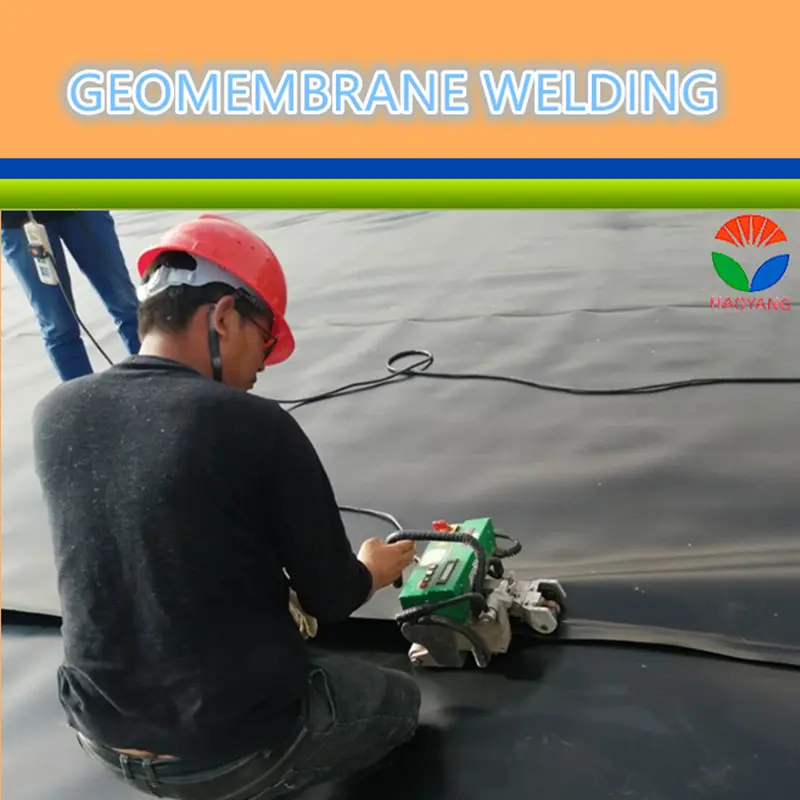The welding of geomembrane is the most critical part of its construction process. Correct welding technology can ensure the tightness and waterproof performance of the joints of geomembrane. The following are the detailed steps, techniques and precautions for geomembrane welding:
1. Welding equipment
1.1. Hot melt welding machine: Hot melt welding machine is a device specially used for welding geomembranes, plastic films and other synthetic materials. It connects by heating and melting materials, and is often used for anti-seepage, repair and reinforcement work in various engineering projects.
1.2. Hot air welding machine: Hot air welding machine is a device specially used for welding synthetic materials (such as geomembranes, plastic sheets, etc.). It uses hot air to heat the joints of the material, melts it, and then presses it together through pressure to achieve the connection of the material. Hot air welding machines are widely used in engineering projects such as waterproofing, anti-seepage and reinforcement.
1.3. Testing instrument: Welding pressure tester is a device specially used to detect the quality and strength of welding joints. It tests the firmness and sealing of the weld by applying a certain pressure to ensure the reliability of the welding joint in actual use. This tester is widely used for welding quality inspection in the fields of geomembrane, waterproof materials, plastic pipes, etc.
2. Welding steps
2.1. Base surface preparation
2.1.1. Make sure the surface of the geomembrane is clean, dry, free of dust, grease and other impurities.
2.1.2. Use a brush or dry cloth to clean the joint area to be welded.
2.2 Geomembrane membrane overlap
Overlap the two geomembranes according to the design requirements, and the general overlap width is between 10 cm and 15 cm.
2.3. Power on the welding equipment for preheating
3. Types of welding equipment and operating principles
3.1. Double-track hot melt welding machine:
3.1.1. Double-track welding principle: The double-track hot melt welding machine uses a heating element to heat the joint part of both sides of the geomembrane to its melting point of 200-300℃, so that the two membranes are fused together at high temperature. During the heating process, the material melts in the heating zone and forms a strong joint after cooling, thereby achieving waterproofing or other connection requirements.
3.1.2. Function: The double-track hot-melt welding machine heats both sides of the membrane at the same time, and can quickly complete the long seam welding task.
3.1.3. Features: It is suitable for large-scale construction and has the advantages of high efficiency and high welding quality.
3.1.4. Application: Large projects such as landfills, sewage treatment plants, and mine tailings ponds.

3.2. Single-track hot-melt welding machine
3.2.1. Principle: The single-track hot-melt welding machine uses a heating element to heat the seam part of the geomembrane to its melting point of 200-300℃ on one side, so that the two membranes are fused together at high temperature. During the heating process, the material melts in the heating zone and forms a strong seam after cooling, thereby achieving anti-seepage or other connection requirements.
3.2.2. Function: The single-track hot-melt welding machine only heats on one side and needs to be moved manually to complete the welding.
3.2.3. Features: It is suitable for smaller projects and simple construction environments.
3.2.4. Application: Small fish ponds, simple swimming pools, etc.
3.3. Hot air welding machine
3.3.1. Principle: The hot air welding machine uses hot air to heat the joint part of the geomembrane to its melting point of 200-300℃, so that the two membranes are fused together at high temperature. Use the hot air welding machine and aim the hot air nozzle at the joint.
Hold the welding machine in one hand and roll the joint with a roller in the other hand to make it fully fused. The material melts in the heating area and forms a strong joint after cooling, thereby achieving anti-seepage or other connection needs.
3.3.2. Function: Use hot air to heat the material joint, and then use manual tools to press it.
3.3.3. Features: Suitable for small area repairs and welding of complex shapes.
3.3.4. Application: Small area repairs, special shape joints.

3.3. Application fields
3.3.1.Geomembrane anti-seepage projects: large-scale projects such as landfills, reservoir anti-seepage, and mine tailings ponds.
3.3.2.Swimming pool and fish pond construction: construction of simple swimming pools and fish pond anti-seepage layers.
3.3.3.Road and bridge engineering: used for road isolation belt and waterproof layer construction.
3.3.4.Underground engineering: construction of waterproof layer such as tunnel and basement.
3.4. Advantages
3.4.1.High efficiency: can quickly complete large-area welding tasks and improve construction efficiency.
3.4.2.High quality: provide high-quality welding seams to ensure anti-seepage performance.
3.4.3.Strong adaptability: can handle various types of geomembrane materials, including HDPE, PVC, etc.
3.4.4.Mature technology: mature technology, widely used, and relatively simple equipment operation and maintenance.
4. Weld test equipment and test methods
After welding is completed, use the test instrument to detect the weld to ensure the welding strength and sealing. Perform air pressure test or vacuum box test to check whether there is air leakage or water leakage in the weld. The main instrument used is the welding pressure tester:

4.1. Working principle
The welding pressure tester simulates the stress conditions in the actual use environment by applying a certain pressure to the welding joint to detect the tensile strength, sealing and durability of the weld. Common test methods include air pressure test and water pressure test.
4.2. Welding pressure test method
4.2.1. Air pressure test
Preparation: Install the sample to be tested in the sealing fixture to ensure the sealing of both ends of the sample.
Pressurization: Inflate the sample with air through the air pump and gradually increase the pressure to the set value.
Detection: Observe the pressure gauge reading, check whether the sample has leakage or deformation, and record the pressure holding time.
Result analysis: If the sample has no pressure drop within the set time, it means that the weld is well sealed; if there is a pressure drop, further inspection and repair of the weld is required.
4.2.2. Water pressure test
Preparation: Install the sample to be tested in the sealing fixture to ensure the sealing of both ends of the sample.
Pressurization: Infuse water into the sample through the water pump and gradually increase the pressure to the set value.
Detection: Observe the pressure gauge reading, check whether the sample has leakage or deformation, and record the pressure holding time.
4.3. Result analysis:
If the sample has no pressure drop within the set time, it means that the weld is well sealed; if there is a pressure drop, further inspection and repair of the weld is required.
4.4. Common problems and solutions
4.4.1. Pressure drop during the test
Reason: The sample or sealing fixture is not sealed tightly and there is leakage.
Solution: Check the sealing of the sample and the sealing fixture, and reinstall or replace the sealing parts.
4.4.2. Unstable test results
Reason: Failure of the pressurizing device or pressure gauge.
Solution: Check and maintain the pressurizing device and pressure gauge to ensure their normal operation.
4.4.3. Sample damage
Reason: The test pressure is too high or the sample quality problem.
Solution: Set the test pressure reasonably, check the sample quality and repair or replace it.
5. Precautions
5.1. Ambient temperature: The welding operation should be carried out at a suitable ambient temperature, and avoid construction at too low or too high temperature to ensure the welding quality.
5.2. Welding speed and pressure: Reasonably adjust the speed and pressure of the welding machine to avoid too fast or too slow to ensure uniform welds.
5.3. Quality inspection: Quality inspection must be carried out after each weld is completed to detect and repair welding defects in time.
5.4. Welding machine maintenance: Regularly check and maintain welding equipment to ensure that it is in good working condition.
6. Common problems and solutions
6.1. Uneven weld: Adjust the speed and pressure of the welding machine to ensure the uniformity of the weld.
6.2. Weld leakage: Check the welding temperature and overlap width to ensure the tightness of the weld.
6.3. Equipment failure: Regularly maintain and calibrate the welding equipment to ensure its normal operation.
By strictly following the welding steps and technical specifications, the welding quality of the geomembrane can be ensured, a reliable anti-seepage effect can be achieved, and the safety and durability of the project can be ensured. If your problem still occurs and cannot be solved, you can contact Haoyang Co., Ltd., and we can provide you with one-on-one guidance and solutions.

698.webp)
191.webp)
